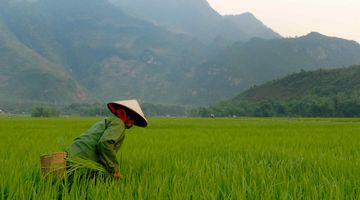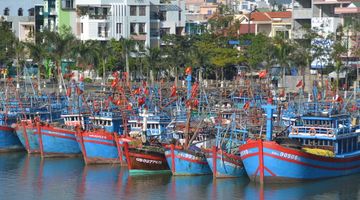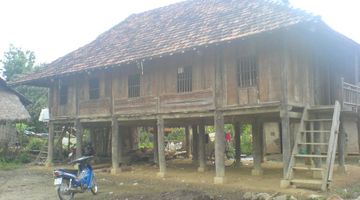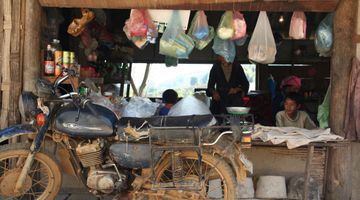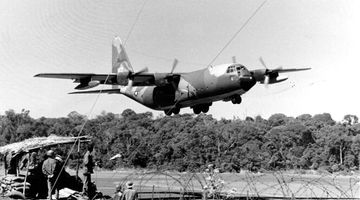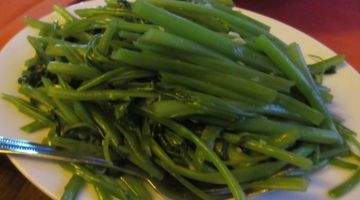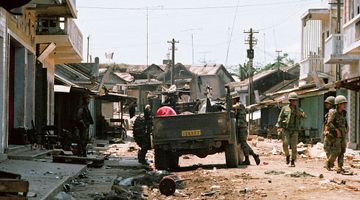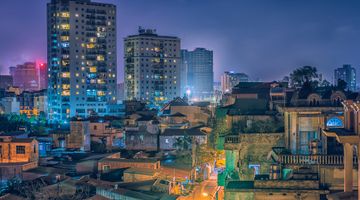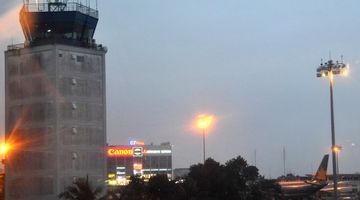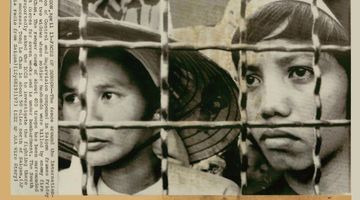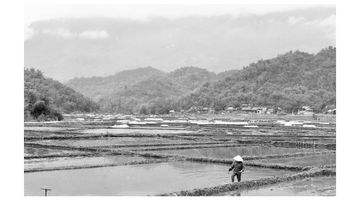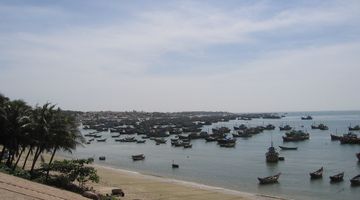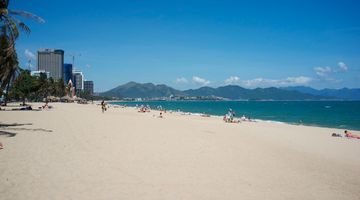Food in Vietnam – Best Dishes and Drinks with Pictures and Useful Tips
Backpackers are flocking to Vietnam in ever-increasing numbers. Most tourists love the food in Vietnam. Vietnamese cuisine balances a range of flavours including salty, spicy, sweet and sour in age-old recipes passed down generations. Favourites include noodle soups, rice and the baguette-like Banh Mi along with a variety of seafood and vegetarian dishes too. Here’s a foodies guide to trying Vietnam’s best traditional food.
Best local dishes to try
So, you’ve just arrived and want to know what to eat in Vietnam to have a traditional culinary experience? Check out the following must-try dishes and street food in Vietnam.
1. Pho
Pho is Vietnam’s most famous food eaten across the country and served in restaurants around the world. The rice noodle soup comes in a hearty broth mixed with various herbs and spices. Visit almost any street side restaurant in Vietnam, and you’ll have the choice between Pho Bo (beef) and Pho Ga (chicken). Try both. When the steamy bowl comes to the table, you’ll have a selection of leafy vegetables and chilli paste to add into your soup.
2. Banh Mi
Banh Mi is one of the legacies of the French colonial days in Indochina. The small baguette with meat, vegetables and pate gets sold on almost every street corner. Vendors push their carts around selling this delicious sandwich, which locals will eat for every meal of the day. The best way to describe this popular food is to imagine a mixture between a subway and a long French baguette but for a tiny percentage of the price.
3. Banh Xeo
Another one of the most delicious Vietnamese delicacies is Banh Xeo, or a type of savoury pancake. The fillings usually contain tasty shrimp and pork with a handful of beansprouts and turmeric. Banh Xeo is then fried creating a mouth-watering snack that’s often eaten with rice paper, leafy green vegetables and a spicy sauce.
4. Cao Lau
Cao Lau, a traditional meal in Central Vietnam, consistently gets rated as one of the best foods from Hoi An. Imagine a delicious bowl of rice-flour noodles mixed with pork and bean sprouts in a light soup. Then add in a side of rice crackers and rice paper, and you have Cao Lau. If you’re in Central Vietnam, you’ll find this dish on most menus and is a must-try food in Vietnam.
5. Bun Rieu
A steaming bowl of Bun Rieu is one of the best soup-based dishes in Vietnam. The broth, made from crab stock, gets mixed with soft rice noodles, tomatoes, fried tofu, pork and congealed pig’s blood. From the description, it might not sound like the most appetising dish. But you’ll be surprised at how good it tastes. As far as delicious Vietnamese food goes, you can’t get much better than a bowl of Bun Rieu with a generous spoonful of chilli and a drop or two of fresh lime.
6. Oc (Shellfish)
Oc, or shellfish, are a popular street-side food in Vietnam. Locals sit on the small plastic chairs and tables by the side of the road as they indulge in cockles, snails and clams. Choose between steamed, grilled or curried ones. Go Vietnamese and snack on the shellfish as you enjoy a cold beer or two. Compared to the West, prices in Vietnam are affordable with a few plates of Oc and some beer coming to no more than $10 (225,000 VND).
7. Xoi
Xoi, in English, is sticky rice. This type of glutinous rice clumps together. In Vietnam, Xoi often comes as a small portion sold by street vendors with pork, chicken or eggs. A local favourite is Xoi with chopped sausage and chicken, which people eat for breakfast. Vendors walk through the streets of Ho Chi Minh City, Da Nang and Hanoi selling portions of Xoi from their carts.
8. Cha Gio
Referred to as Cha Goi in Southern Vietnam and Nem Ran up north, the small fried spring rolls are a delicious, albeit unhealthy, must-try food in Vietnam. Typical fillings include chopped vegetables, minced meat (often pork), tofu and crab. When your plate arrives, dip the spring roll into the accompanying tangy sauce and enjoy.
9. Bun Cha
In 2016, former president of the United States, Barack Obama, made an official trip to Vietnam. When he arrived in Hanoi, the first meal he ate was Bun Cha. Bun Cha, a rice noodle based dish with charcoal grilled meat, is northern Vietnam’s most famous dish. You can find Bun Cha in all parts of the country with each having their own version and tastes. After Obama ate Vietnam’s national dish, he gave nothing but positive feedback. And you’ll say the same after trying it too.
10. Com Tam
Hungry and looking for a light meal? Head to one of the small restaurants advertising ‘Com Tam’. The dish consists of broken rice with a barbequed pork chop along with pickled vegetables. Pork is cooked by the side of the road. A meal typically costs less than $1 (22,000 VND).
Five best local drinks to try
Apart from enjoying the local food, be sure to sample some of Vietnam’s speciality drinks. Whether you want to sip a cup of strong black coffee in the morning or enjoy a glass of local beer in the evening, the following aren’t to be missed.
1. Ca Phe Sua Da
Vietnam’s other claim to fame is coffee. People around the globe instantly fall in love with the creamy filtered coffee. Drip filtered into a tall glass with ice, Vietnamese coffee is both delicious and strong. There are two types to choose from when you’re inside one of the attractively decorated cafés. Either Ca Phe Sua Da, with thick condensed milk, or Ca Phe Da, black without milk. A glass of Vietnamese coffee costs approximately $1.30 (30,000 VND).
2. Tra Sua
Tra Sua, Vietnam’s version of bubble tea, is a favourite with locals of all ages. A milky iced tea with either small chunks of fruit jelly or balls of tapioca provides the ultimate refreshment on a hot afternoon. In the café, you’ll have the choice between several varieties. Vendors also roam the streets selling from their carts.
3. Nuoc Mia
As you walk around, you’ll often see small stalls with long bamboo-like branches stacked up nearby. When someone orders a drink, the hawker inserts it between two metal rolls and crushes the branch to create a drink. This is called Nuoc Mia, or sugarcane. Expect a super sweet drink. Some people love Nuoc Mia while others hate it. Try this drink at least once in Vietnam and make up your own mind.
4. Bia Hoi
The Vietnamese like to drink beer. Bia Hoi is a type of local draft beer. A 330ml glass costs less than $0.50 and often drank in small street side bars on tiny plastic tables and chairs. If you’re a fan of beer, be sure to check out Vietnam’s draft beer.
5. Rice Wine
Rice wine, an alcoholic drink from fermented and distilled rice, comes in many varieties around South East Asia. Vietnam food culture often intertwines with drinking culture. For this reason, you can find several types of rice wine in Vietnam. The strong spirit gets drunk at parties. Foreigners are usually invited to join. Sticky rice wine, or ruou nep cam, is a favourite type among some locals. Others rice wines get mixed with herbs and sometimes a snake. Walk through Ben Thanh Market in Ho Chi Minh City and you’ll see small jars of liquid with snakes inside. This is snake rice wine.
Food prices
Compared to the West, Vietnam food prices are low and inexpensive. The typical cost of traditional food tends to be similar to other countries in South East Asia.
Depending on where you go, a meal in a local restaurant shouldn’t cost more than $10 (225,000 VND) per person. This typically includes a plate of rice with at least two sides and a drink or two. Head into the touristy areas and the cost of food increases. If you’re on a tight budget, go to the local restaurants where a bowl of Pho and other types of Vietnamese food should cost no more than $2 (45,000 VND). Street food comes to around $1 (22,500 VND).
Be aware of places that don’t advertise the price. They’re likely to charge foreigners extra or try to scam you.
Western Food, like in most backpacking spots in Asia, tends to be much more expensive compared to local dishes. But, it’s still going to be very affordable compared to what you’re familiar with back home. A range of international cuisines such as Western, Italian, French, Indian and Japanese food is readily available in Ho Chi Minh City and Hanoi. Expect to spend at least $15 (340,000 VND) per person.
Food security
The quality of local food varies. Hygiene, even in the upscale restaurants, may be substandard. In terms of Vietnam food security, exercise caution when choosing a place to eat. It’s not uncommon for tourists to get sick in the first few days.
Hygiene is inadequate in many local restaurants. Food might not be stored at the correct temperature becoming a breeding ground for bacteria. Contamination from grime, litter and the notorious pollution might be an issue as well. The lack of hygiene is easy to imagine when you consider the prevalence of nose picking, lack of hand washing and how waiters put food from the floor back onto the plate. You can expect to find hairs in your soup or meals too in the local restaurants.
Another aspect of hygiene is ice. The vast majority in Vietnam is safe. But if you have a glass of beer with ice, waiters will replace as it melts. Your ice goes back into the bucket and is then recycled into other people’s drink. The new ice in your glass might have come from the table opposite. Just be aware of this. The best way to avoid this is to insist on a drink from the fridge. Or just don’t change your ice.
Tourists with special dietary requirements in Vietnam might find travelling difficult. MSG is widely used in all types of cooking. And finding Halal food outside of speciality restaurants can be challenging. Vietnamese eat a lot of pork and cooking oil gets recycled.
Some daring tourists may want to try the more unusual food in Vietnam the country is infamous for, especially exotic meat. If you’re squeamish or an animal-lover, don’t read the next sentences! The definition in the West of edible meat varies to that in Vietnam. If you’re adventurous, you might have the opportunity to eat snake, turtle, field mice, bats, grilled fox meat, balut (a fertilised chicken or duck egg) and the notorious dog (thit cho) and cat meat (thit meo). Only speciality restaurants serve these dishes. You won’t eat one of the above by mistake in a regular restaurant.
Best restaurants to dine
Depending on where you visit in Vietnam, you’ll probably have a large selection of restaurants available. Here are some of the must-visit places to eat in different parts of the country
Healthy Farm, Ho Chi Minh City
The chain restaurant specialises in vegan and vegetarian food in Vietnam. You can find branches in most Ho Chi Minh City districts. Dining here guarantees to meet any specific dietary requirements you may have. Healthy Farm has a dining area and takeaway options.
May Restaurant, Ho Chi Minh City
The high-end restaurant in Ho Chi Minh City’s District One fuses Vietnamese styles with French flavours. Housed in a former colonial villa, Mai Restaurant not only has an authentic theme but serves some of the best flavours in Vietnam.
Story Beach Club
Looking for a unique culinary experience in Nha Trang? Check out Story Beach Club whose menu is filled with Vietnamese, Chinese, Mediterranean and Eastern European specialities. Thousands of Russian tourists visit Nha Trang each year. This restaurant caters for those looking to eat something familiar.
Cua Bien Quan, Da Nang
For an exceptional dining experience with views of the sea, head to Da Nang’s Cua Bien Quan. Fresh seafood, oysters and clams are on the menu. You can choose between eating al fresco dining and dining in an air-conditioned room.
Bun Cha Huong Lien, Hanoi
This small restaurant in Hanoi once sat in the depths of obscurity. Nothing set it apart from the thousands of others in the capital city. That was until former President Obama and American Chef Anthony Bourdain ate here in 2016. Since then, the typical Vietnamese restaurant with small plastic chairs rose to fame. If you’re in Hanoi, why not order bun cha and dine as Obama did.
Learning to cook Vietnamese food
If you love Vietnamese cuisine, why not attend a cooking school and learn how to prepare your favourite food when you return home?
Vietnam Cookery Centre
Located in District One and costing $37 per lesson, the Vietnam Cookery Centre was the first establishment to teach tourists how to cook Vietnamese cuisine. Learn how to prepare your favourite dishes including spring rolls and soups. The instructors have a good command of English and are friendly and chatty towards tourists. A typical class lasts a few hours.
Hanoi Cooking Centre
If you’re in Hanoi and want to learn how to cook some of the best specialities from Northern Vietnam, book at class at Hanoi Cooking Centre. The school, on Chau Long Street, provides hands-on cooking lessons and various workshops. Highlights include learning how to prepare Vietnamese street food, spring rolls, vegetarian dishes and some of the other favourites from Hanoi. You can also learn how to cook beef noodle soups and the best ways to prepare rice. Lessons are slightly more expensive at $60 per class. But, students often come away with all the skills they need to replicate the food in Vietnam back at home.
Da Nang Cooking Class
The cooking class in Da Nang rates as one of the best in the country. Unlike other schools, tourists get the full experience from two local tour guides. Classes start either in the morning or afternoon lasting approximately five hours. You’ll get a guided tour of the local markets, go to vegetable gardens and visit a traditional house. After this cultural immersion, you’ll have the chance to prepare simple dishes after buying all the fresh ingredients from the nearby markets.
Conclusion
The food in Vietnam is delicious. Be sure to sample as many traditional dishes as possible and wash it down with a glass of bia hoi or a strong cup of coffee. And if you, like many others, fall in love with Vietnamese cuisine, book a class at one of the cooking schools and bring the meals back home.
